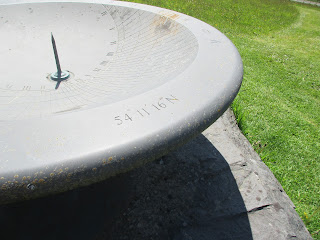Passing Time On A Wet day
In Cumbria we have just had the wettest May on record. At a Latitude of 54 degrees North our flower display are far behind the rest of England.
Last week I visited Holker Hall and Gardens, Cark In Cartmel - the planting schemes did not disappoint. The wet and cold weather has given us amazing displays of bluebells, Rhododendrons and Azaleas.
In the middle of the wild flower meadow is a beautiful slate sun dial clearly stating that we were 54 degrees 11' 16" North.
The area is warmed by the Gulf Stream as it drifts through Morecambe Bay on its journey from the southern United States of America. Without the Gulf Stream England would have a similar climate to the state of Alaska.
When I left home the rain was falling from a grey sky. A one hour drive south to Holker Hall and the sun was shining, the sky blue.
The Holker Hall sundial is a fine example of Burlington Grey Slate, unlike the usual stone employed by dial makers, slate can be expected to withstand the weather and atmospheric pollution with little change. Lord and Lady Cavendish commissioned Mark Lennox Boyd to design this unique dial in the shape of a shallow bowl emulating the earliest known sundial invented some 2300 years ago. The diameter of the sundial is 5 feet. The dial is marked into 15 minutes divisions for date with six divisions for the twelve signs of the zodiac: from Capricorn to Gemini on the west rim as the days get longer, and Cancer to Sagittarius on the East rim as the days get shorter. The latitude is also marked on the dial, together with a table of correction for GMT (Greenwich Mean Time).
Slate is a major industry in Cumbria. Burlington Stone is owned by the Cavendish family of Holker Hall, who bring 450 million years of British geology and 170 years of quality British craftsmanship into the heart of homes and gardens all over the world. There are eight quarries located in Cumbria and the English Lake District. Pure Lakeland water, natural weathering and mineral processes have slowly transformed the stone, lending it unique technical characteristics. Low water absorption means it is colour fast, robust and easy to clean and maintain. Deep within the stone lies its true beauty, rich detail, sensitive tones and textures.
The Labyrinth and Cascade and Burlington Fountain - Holker Hall Gardens
The Holker Labyrinth was inspired by a design from a Hindu Temple and influenced by the tradition of Cumbrian Stone Circles. From the wild flower meadow you will frequently see the rare breed Menil Fallow Deer.
Holker's stunning gardens have been developed by generations of owners and gardeners. The earliest records of the gardens date back to the 1720's when Sir Thomas Lowther and his wife, Lady Elizabeth Cavendish were the owners. They created formal gardens with clipped topiary hedges, embellished with statues which were transported by ship from London, few of these statues remain today. The formal gardens are full of displays of colour and interest. A curved Pergola leads to the Rose Garden both were designed by Thomas Mawson (1861-1933), landscape gardener, in 1908
Winding paths take you through a collection of rare plants and trees that strive in the micro-climate of the Cartmel Peninsula. There are acres of undulating parkland and pastures at Holker through which to wander.
Passing time on what started as a wet day could not have been more interesting.






Comments
Post a Comment